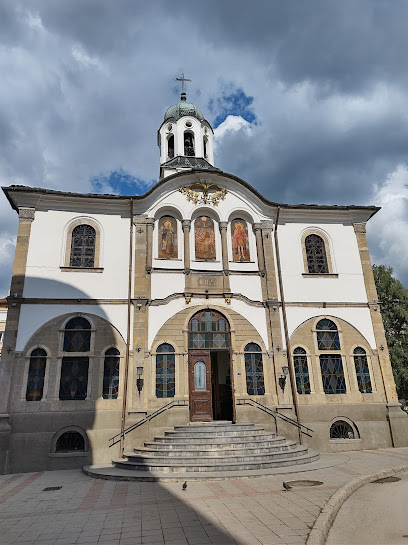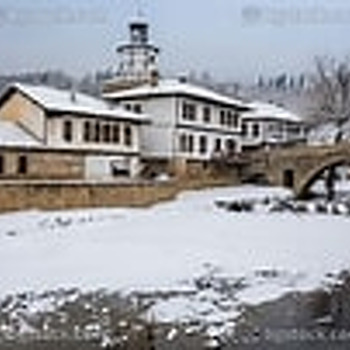Church of the Dormition of the Mother of God in Gabrovo
Overview
The Church of Dormition of the Mother of God is a masterpiece of Bulgarian Revival church architecture.
The church was built near the first Gabrovo church "St. Petka" in honor of St. Petka. The relics of Sveta Paraskeva / Petka / Epivatska pass through Gabrovo on the way to Tarnovo / 1231 /. At the place where the relics spent the night, the population built a church, and St. Petka became the spiritual protector of the city. The temple also existed during the first centuries of Ottoman rule. In 1798 the troops of Kapudan Hussein Pasha devastated Gabrovo. Along with countless destructions, the church was burned down.
In 1704, with a certification, which was a decision of the temporary judge in Tarnovo, based on a sacred sultan's order, the inhabitants of Gabrovo received permission to repair their church "St. Petka". The reason for this permission is that it is "from before the conquest". This document is proof of the existence of a large enough settlement with a church during the Second Bulgarian Kingdom, which is preserved in the following centuries. But it was not restored, and in 1804 a new church "Assumption of the Blessed Virgin" was built south of it without official permission from the authorities. It is small, covered and dug into the ground. When it became clear that there were no documents for its construction, the people of Gabrovo temporarily housed saddlers / masters of horse saddles / in order to prevent its closure.
In the 19th century, Gabrovo was already an important educational, commercial and economic center. The inhabitants of the city have gained a certain self-confidence and want a more majestic temple to suit them. Therefore, the old church was destroyed on May 5, 1865, and on May 11, 1865 the construction of the new building began.
The church was completed in 1866 by the great Revival master Usta Gencho Kanev. He is the architect of the Aprilov High School building in Gabrovo, as well as of church buildings in Romania and Greece.
The new church was consecrated on October 26, 1866 by four priests - Archimandrite Priest Sylvester, Hristo Yovchev Bocharov, Stefan Stanimirov and Priest Ivan Gabenski.
The church is located in the central part of the city overlooking one of the most beautiful stone bridges on the Yantra River - Baev Bridge.
Felix Kanitz / 1871 / wrote:
In the last church "Assumption of the Blessed Virgin", erected by the skilled master builder from Tryavna Gencho in 1866, there is a very beautiful carving of walnut wood; for the view of the city, it is no less magnificent than the new school with 19 front windows. "
Dr. Petar Tsonchev in 1934 tells the following curious story:
"Until the middle of the 19th century, the churches did not have bells, but wooden rivets, because the Turkish authorities did not allow it. But for the new church, the people of Gabrovo specifically asked to have a bell and it was delivered from abroad. The Turks did not allow her to be hanged and to fight. The people of Gabrovo took her to the Sokol Monastery. With the accession to the throne of Sultan Azis / June 1861 /, two people from Gabrovo, "the most zealous of the young", came up with the idea to use the holiday as an occasion and to hang the bell. The celebration lasted 3 days. On the night before the third day, they brought the bell from the Sokol Monastery and hung it on the bell tower, without anyone suspecting their intention. Early in the morning, along with the eyelids, the bell begins to ring. This shocked the Turkish authorities, but pleasantly surprised the people of Gabrovo. Turkish authorities have arrived to see what is happening. The population assured them that there was no more solemn way to express their loyal feelings to the new sultan than by ringing the new bell. So she stayed where she was.
The church is a three-nave basilica, with two domes and two rows of four columns. The master is also the author of the decorative decoration of the church, consisting of stone reliefs with plant and animal motifs.
The iconostasis was made of linden wood for only 3 years / 1882 - 1885 / and is a remarkable example of post-liberation woodcarving.
The icons on the facade were restored by the artist Adolf Selof.
Recommended
- Museum House of humor and satire
- Planetarium
- Monument to Racho Kovacha
- Dechkova house
- Interactive Museum of Industry
- Museum of History
- National Museum of Education
- Art Gallery
- Gradishte Fortress
- Sokolski Monastery
- Ethnographic complex Etar and others


 Bulgarian
Bulgarian Romanian
Romanian



